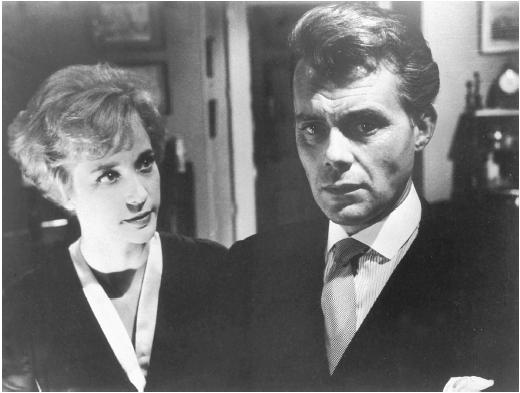VICTIM - Film (Movie) Plot and Review
UK, 1961
Director: Basil Dearden
Production: Allied Film Makers/Parkway. A Michael Relph and Basil Dearden Production; black and white; running time: 100 minutes; length: 9,000 feet. Released 1961.
Producer: Michael Relph; screenplay: Janet Green, John McCormick; photography: Otto Heller; editor: John Guthridge; sound: Leslie Wiggins; sound recordists: C. C. Stevens, Gordon K. McCallum; art director: Alex Vetchinsky; music: Philip Green.
Cast: Dirk Bogarde ( Melville Farr ); Sylvia Syms ( Laura ); John Barrie ( Det. Inspector Harris ); John Cairney ( Bridie ); Norman Bird ( Harold Doe ); Peter McEnery ( Barrett ); Anthony Nicholls ( Lord

Publications
Books:
Hinxman, Margaret, and Susan d'Arcy, The Films of Dirk Bogarde , London, 1974.
Hill, John, Sex, Class, and Realism: British Cinema 1956–63 , London, 1986.
Tanitch, Robert, Dirk Bogarde: The Complete Career Illustrated , London, 1988, 1990.
Articles:
Wilson, Cecil, "Bogarde's First 'X,"' in Daily Mail (London), 19 August 1961.
Times (London), 30 August 1961.
Dyer, Peter John, in Monthly Film Bulletin (London), September 1961.
Dehn, Paul, in Daily Herald (London), 1 September 1961.
Powell, Dilys, in Sunday Times (London), 3 September 1961.
Variety (New York), 6 September 1961.
Whitebait, William, in New Statesman (London), 8 September 1961.
Cinématographe Française (Paris), 9 September 1961.
Partridge, Bruno, "Some Chances Taken, and Some Not," in Time and Tide (London), 14 September 1961.
Films and Filming (London), October 1961.
"A Plea for Perversion?," in Time (New York), 23 February 1962.
Kael, Pauline, in I Lost It at the Movies , Boston, 1965.
Film Form (London), autumn 1977.
Medhurst, Andy, "Victim : Text as Context," in Screen (London), July-October 1984.
Medhurst, Andy, "Dirk Bogarde," in All Our Yesterdays , edited by Charles Barr, London, 1986.
Stuart, Jan, in The Advocate , no. 744, 14 October 1997.
Lugowski, David M., in Cineaste (New York), vol. 23, no. 3, April 1998.
Umland, Rebecca, and Sam Umland, " The Night Porter / Victim ," in Video Watchdog (Cincinnati), no. 45, 1998.
* * *
Victim is one of an impressive series of social problem films that Basil Dearden directed and Michael Relph produced between 1944 and 1963. Stylistically (and morally) they change very little, and to the radical young critics of the early 1960s Dearden and Relph epitomised everything that was wrong with British cinema. According to Victor Perkins, "Their method is to devise a number of stereotypes to represent every possible attitude to the matter in hand. . . . Thus in Sapphire and Victim , Basil Dearden and his scriptwriter Janet Green have produced thriller-problem films that work neither as thrillers nor as examinations of a problem, and particularly not as films." It is hardly a recommendation that Dearden and Relph were smiled on by the industry and liked by the more conservative critics, but now that the heat of battle has died down it is possible to see considerable virtues in their work—a civilised tolerance, a shrewd ability to combine exciting narrative stories with a less than superficial analysis of serious social problems, and a particular ability to probe and prod at English sexual repression.
Victim was the second of Dearden's and Relph's three collaborations with the talented scriptwriter Janet Green and the first British film to deal seriously and openly with homosexuality. The film takes its cue from the 1957 Wolfendon Report, which recommended the decriminalisation of homosexuality between consenting adults— proposals that were not enacted by Parliament until 1968. In its efforts not to be exploitative and sensational, Victim makes the lives of homosexuals seem sad, drab, pathetic. As one of the despairing victims puts it, "nature played me a dirty trick . . . tell them there's no magic cure for how we are." Gay writers like Richard Dyer and Andy Medhurst, while acutely aware of the film's limitations, have also seen good things in it—particularly Dirk Bogarde's portrayal of a man whose love, however deeply repressed, is reserved for other men.
Stylistically the film is much more distinguished than it has been given credit for. Dearden and Relph—and the veteran art director Alex Vetchinsky—make good use of the opportunity to break out of the studio and explore a hitherto unseen London. The Salisbury, a glittering Edwardian pub in St. Martin's Lane, well known even then as a gay meeting-place, is used effectively as the focal point of the film's homosexual community; and Otto Heller's lighting is superbly effective in creating a world that is always precarious and vaguely threatening. Perkins is right in the sense that all the characters— with the notable exception of Bogarde's sexually ambivalent hero— are stereotypes, but they are stereotypes who are cleverly deployed to get across the film's message that homosexuals are ordinary people from all walks of life rather than sub-criminal freaks.
Finally, though, it is the relationship between Bogarde and Sylvia Syms that now seems to give the film a dark resonance entirely missing from, for example, the Warner Brothers social problem films of the 1930s. In earlier British films like Brief Encounter, The Passionate Friends , and Mandy , it is women's sexuality that is the problem, as repressed but passionate women become discontented with their dull, drab husbands. In Victim it is Bogarde who is unable to adjust, tempted away from his dutiful, attractive wife by a passion that is all the more real because it is inappropriate to his career, his status, and his peace of mind.
—Robert Murphy
Comment about this article, ask questions, or add new information about this topic: